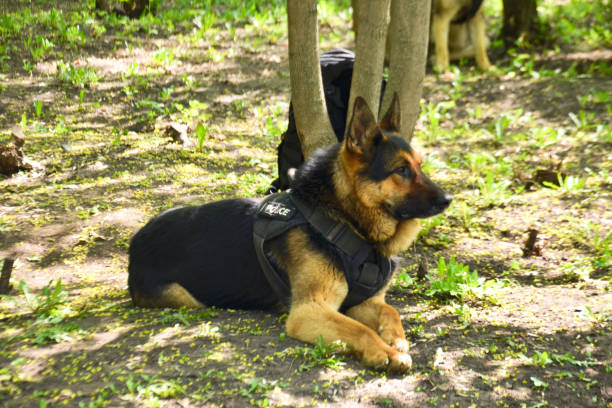Choosing a good harness for German shepherd is important because of their powerful, lively, and active nature. different normal collars, a harness provides better control, absolutely during walks or training sessions, lower the strain on your dog’s neck, and prevents possible injuries. A well-fitted harness divides pressure evenly across the chest and shoulders, making it more comfortable for your German Shepherd while giving you more handling power. This is particularly useful when dealing with their natural pulling instinct, making walks safer and more lovely for both of you.
Having the right good harness for German shepherd isn’t just about control—it’s also a problem-solver. A good harness for German shepherd can help manage observable issues like too much pulling, jumping, or lunging. It also enhances safety by preventing your dog from slipping out, which is a common problem with collars. Additionally, features like adjustable straps, padded materials, and thoughtful elements ensure your dog’s comfort, safety, and clarity. In short, investing in a good harness for German shepherd is important for maintaining your dog’s well-being and strengthening your bond during outdoor activities.
Why a Harness is Important for German Shepherds
German Shepherds are strong and effective dogs, and traditional collars can cause dangerous stress on their necks, particularly if they tug. This can result in accidents along with tracheal harm. That’s why using the correct harness for German shepherds is a safer choice. A harness distributes pressure calmly throughout the chest and shoulders, imparting higher control and decreasing the danger of harm.
Key Features to Look for in a Harness for German Shepherds
- When looking for a suitable harness for a German shepherd, there are numerous important features to keep in mind. These features will ensure that the harness is snug, secure, and effective for your dog’s needs:
- Durability: German Shepherds are sturdy and energetic puppies, so you need a harness made from brilliant, tear-resistant substances like nylon, polyester, or leather-based. A durable harness will withstand your dog’s strength and remain for years.
- Adjustability: German Shepherds are available in exclusive shapes and sizes, so it’s vital to pick a harness with more than one adjustment point. This feature allows you to customize the harness to your canine’s body, ensuring it’s snug but not too tight.
- Padding: A harness with padded straps and chest plates will offer extra consolation, specifically throughout long walks or hikes. Padding facilitates preventing chafing and inflammation, which may be a hassle with poorly designed harnesses.
- Reflective Elements: If you often stroll your dog at night or in low-mild conditions, a harness with reflective strips or sewing will make your dog more visible to drivers and pedestrians, improving their safety.
- Ease of Use: Look for a harness with a brief-launch buckle or a step-in layout. These features make the harness simple to position on and take off; that’s helpful for impatient or wiggly puppies.
- Control Features: If your German Shepherd tends to drag on the leash, remember a no-pull harness with a front-clip attachment point. This design redirects your canine’s momentum toward you, making it simpler to manipulate them. Some harnesses also come with a handle at the back, which can be useful for steering your canine in crowded regions or all through training.
Harness vs. Collar—Which is Better?
Why Harnesses Are Safer for German Shepherds

Harnesses are safer for German Shepherds because they distribute pressure evenly across the chest and shoulders, reducing the risk of neck and spine injuries. A good harness for German shepherd offers better control, minimizes strain, and ensures comfort during walks and training.
Collars Can Cause Neck Strain—What You Need to Know
Collars can put harmful pressure on a German Shepherd’s neck, leading to strain, choking, or even long-term damage. Harnesses reduce this risk by distributing force evenly, making walks safer and more comfortable for your dog.
Top Harness Options for German Shepherds
Here are some of the best harnesses for German Shepherds, based on their durability, comfort, and functionality:
Ruffwear Front Range Harness
This top-rated dog harness is known for its durability and comfort, making it a popular choice for active dogs.
It features a dog harness that clips in front for better control and reflective trim for visibility in low-light conditions.
It is ideal for hiking, walking, and outdoor adventures.
Kurgo Tru-Fit Smart Harness
This harness is crash-tested for car safety, making it a fantastic option for travel.
It has adjustable straps and a no-pull harness D-ring for training purposes.
Lightweight and comfortable for everyday use.
Julius-K9 IDC Powerharness
This heavy-duty Police Dog Harness is designed for strong dogs and features a handle for added control.
It comes with customizable side patches, allowing you to personalize the harness.
Excellent option for working dogs or those who tend to tug.
Petsafe 3-in-1 Harness
This versatile harness has three leash attachment points, giving you flexibility in how you use it.
It has a soft, padded chest plate for comfort.
Ideal for training and managing pulling behavior.
Blue-9 Balance Harness

This harness is designed to reduce stress on the neck and spine, making it a good choice for dogs with sensitive necks or back issues.
Fully adjustable for a perfect fit.
Great for dogs that need extra support during walks or training.
How to Measure Your German Shepherd for a Harness
To ensure the perfect fit, you’ll need to measure your German Shepherd before purchasing a harness. Here’s how to do it:
- Chest Girth: Measure the widest part of your dog’s ribcage, just behind their front legs.
- Neck Circumference: Measure around the base of your dog’s neck, where a collar would normally sit.
A properly fitted harness should be snug but not too tight, allowing you to fit two fingers between the harness and your dog’s body.
Tips for Training Your German Shepherd to Wear a Harness
A harness may initially frighten your German Shepherd, but patience and positive reinforcement can help. Choosing a good harness for German shepherd is key to ensuring both comfort and ease during this process. Here are some tips:
- Introduce the Harness Slowly
Let your dog sniff and examine the harness before submitting it. This helps them feel more comfortable with the new gear.
- Use Treats and Praise
Reward your dog with treats and praise when they allow you to put the harness on.
- Start with Short Sessions
Begin by having your dog wear the harness for short periods, gradually increasing the duration as they become more comfortable.
- Check for Comfort
Make sure the harness fits properly and doesn’t cause chafing or irritation.
Why Choosing the Right Harness Matters
- Prevents aches, chafing, pores, and skin irritation.
- Reduces the hazard of your dog slipping out or escaping.
- It allows natural movement without limiting mobility.
- It ensures a comfortable suit—best when hands can match between the straps and your canine’s body.
- Distributes stress frivolously throughout the chest, reducing pressure on the neck.
- Provides higher control, especially for robust pullers like German Shepherds.
- Enhances protection during walks, stopping surprising jerks or lunges.
- This product offers an extra comfortable and secure strolling experience for each canine and owner.
FAQs
What size harness does a German Shepherd want?
Most German shepherds need a huge or larger harness, depending on their size. Always measure before shopping.
How do I prevent my German Shepherd from pulling at the leash?
Use a no-pull harness with a front clip and teach your dog the use of superb reinforcement.
Is the front-clip or returned-clip harness better?
A front-clip dog harness is ideal for training and reducing pulling, while a back-clip harness works well for casual walks.
Can a harness assist with schooling my German Shepherd?
Yes! A robust harness provides higher manipulation and maybe a treasured training device for leash manners.
How regularly do I need to update my canine’s harness?
Check for signs and symptoms of wear and tear often. Replace the harness if the cloth is fraying, the buckles are free, or it no longer suits nicely.
Conclusion
An accurate harness for a German shepherd is more than simply a bit of a system—it’s a device for making sure of safety, comfort, and manipulation in the course of walks. The right harness will distribute pressure calmly, prevent pulling, and allow your canine to transport freely without soreness. Investing in a brilliant, properly outfitted harness can enhance your everyday walks and education sessions. With the right choice, you’ll revel in a more potent bond and a happier, higher-behaved German Shepherd.
Whether you’re seeking a police dog harness, a tactical harness, or a top-rated canine harness, selecting the proper German Shepherd harness is critical for your canine’s safety and comfort. Be sure to consider features such as adjustability, durability, and reflective elements when choosing a harness for your furry friend.

